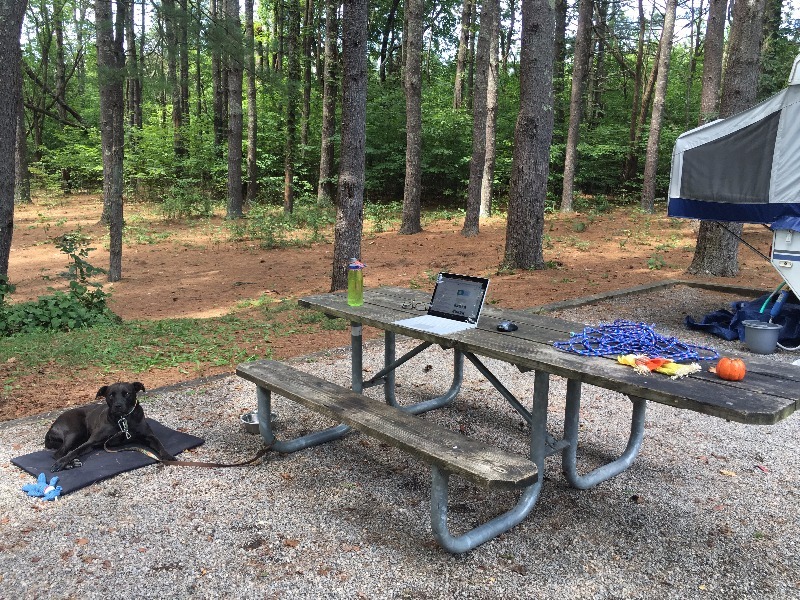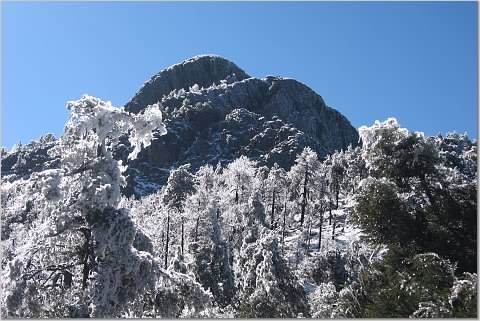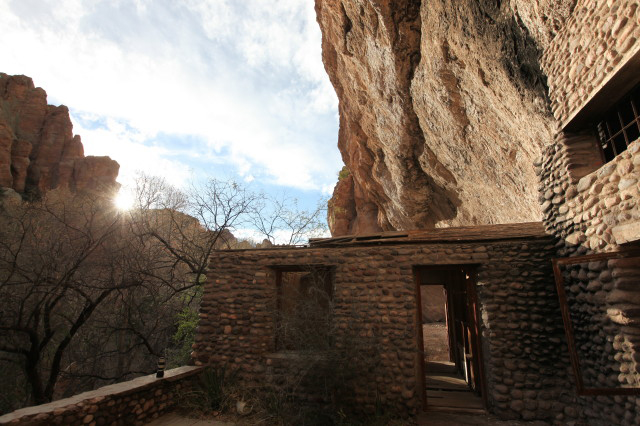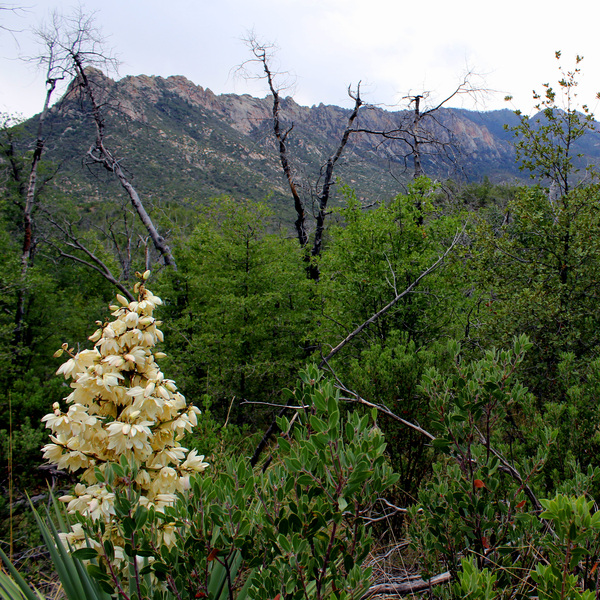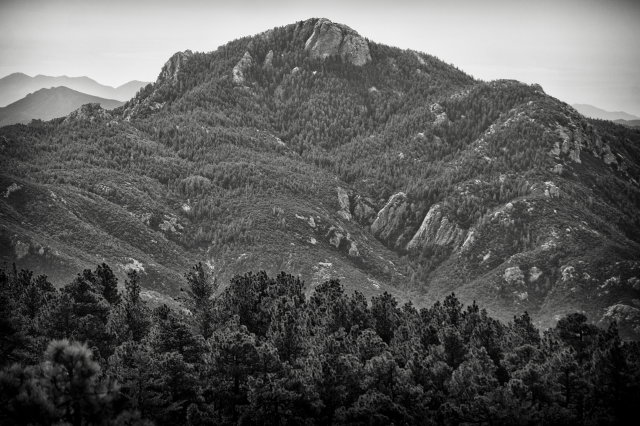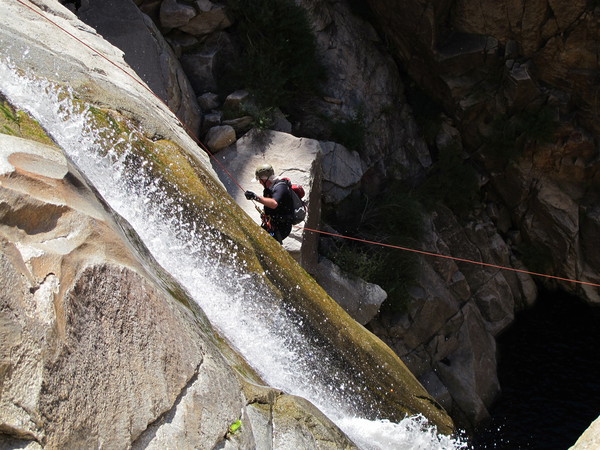It’s been way too long since I’ve had a chance to update this blog about my recent adventures, but I’m happy to report that a BIG ONE is beginning TOMORROW!
If all goes as planned, I will have rounded up the husband, the dog (we recently adopted one – more to come on that soon!), and a bunch of gear by mid-morning. I’m pointing Chief the Jeep and the currently nameless pop-up camper towards New Mexico and embarking on an extended working/camping/exploring road trip to the Southwest for a wonderfully indefinite amount of time!
So I thought there was no better time than the present to share a guest post from the founder of an Tuscon, Arizona-based adventure travel company I recently connected with by the name of Mitch Stevens. Mitch is the founder and lead guide of Southwest Discoveries, and he was kind enough to share some Arizona hiking expertise with me and my readers. Whether on this upcoming trip or a future one, I hope to check out some of these awesome-sounding Southwest hikes very soon.
——————————————————————————————————————–
It’s a well known fact that Arizona is beautiful, often breathtakingly so. In this post, we will introduce five of the most awesome, wondrous and secluded hikes in the southwest. From the fascinating Sonoran Desert in southern Arizona to the red rock country near Sedona and the Grand Canyon, Arizona features a staggering diversity of landscapes, perfect for Arizona Day Trips and adventures. But with so many amazing places to trek, just where to you draw the line? Allow us the opportunity to present to you five of the most awesome, wondrous and secluded hikes in the southwest that are perfect destinations for your next hiking adventure.
The first of our five Day trips in Arizona offering big, uninterrupted space, plenty of cactus and southwestern flora to experience and the unspoiled splendor of one of Earth’s major ecosystems.
1. Mt. Ajo – Organ Pipe Cactus National Monument
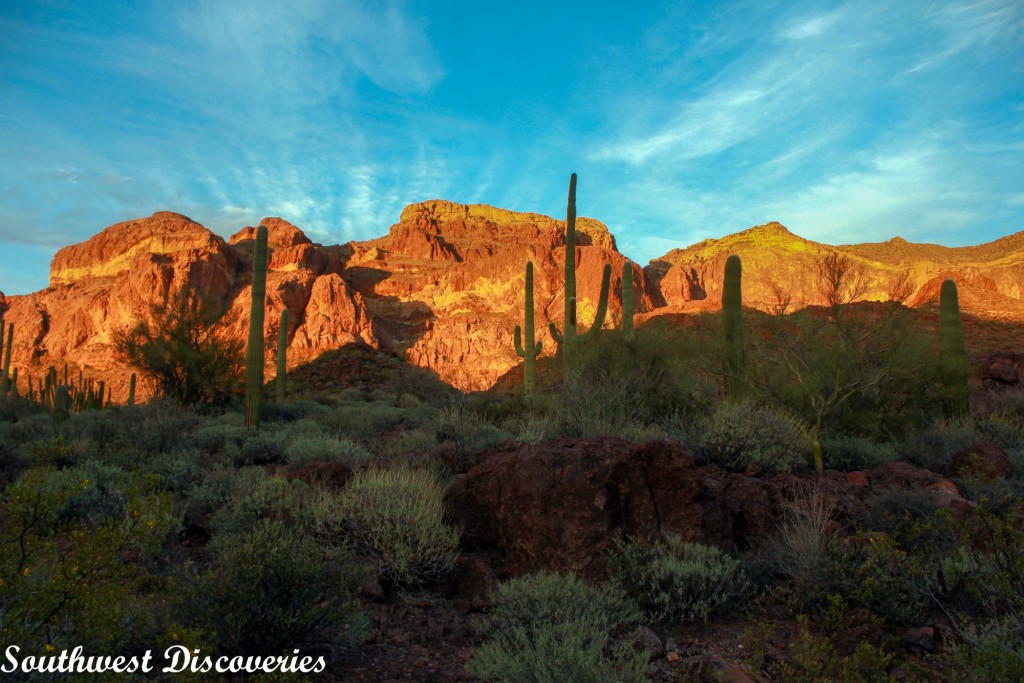
As a trip leader and interpretive guide, Beth Krueger knows the desert. She once spent four days camped at Organ Pipe Cactus National Monument, surveying birds and other wildlife. While most hikers avoid summers in this part of the world, this is Beth’s favorite season. At this time of year, she can savor the fruit of the organ pipe cactus, purported to be the best tasting in the world.
Beth and I collaborated on a late winter outing at the park’s nearly pristine desert wilderness, celebrating the life and landscape of the Sonoran Desert. Our group hiked to the summit of Mt. Ajo, an incredibly beautiful trek which enabled us to experience the Sonoran Desert at it’s finest.
We marveled at magnificent organ pipe and saguaro cacti as well as a rich assortment of extraordinary plants. The preserve is a showcase for plants and creatures who have adapted to the extreme temperatures, intense sunlight, and little rainfall that characterize this southwest region. Located between Arizona’s Ajo Mountains and the Mexico border, Organ Pipe is the only place in the United States where the organ pipe cactus appears, rare in the United States but common in Mexico
A hiker can explore many sections of this international biosphere preserve where big views, uninterrupted space, lots of the namesake cactus and one of the Earth’s major ecosystems survives in almost unspoiled splendor. The monument lies next to Cabeza Prieta National Wildlife Refuge, which is connected to the Barry Goldwater Air Force Range. Together, these lands represent a large, unbroken desert habitat, home to species such as the endangered Sonoran pronghorn, Quitobaquito pupfish and desert bighorn sheep.
Our group hiked one and a half miles through dense stands of giant columnar cactus to the Bull Pasture overlook. There are exceptional views in every direction. The immediate surroundings are filled with smaller peaks, canyons, and other rocks formations; and in the distance are more mountains. If winter rains are generous, this vicinity of the park erupts with dense stands of Mexican Gold Poppies and other gorgeous wildflowers.
After we left Bull Pasture, the official trail ended and the unofficial cairned route began. A series of switchbacks quickly took us up several hundred feet, and the views just kept getting better. Before long, boulders and rock formations that were part of the backdrop at the beginning were now right in front of us. After a few short, steep switchbacks with some loose footing, the route meandered alongside amazing rock outcrops, including windows, arches and a series of huge cone-like stone formations.
At this point, the awesomeness factor jumped to a whole new level. After another mile of hiking on a ridgeline with stunning views, a short but fun boulder hop landed us atop Mount Ajo, the tallest mountain in Organ Pipe Cactus National Monument.(http://www.nps.gov/orpi/index.htm) We scrambled a short distance on the summit and more grand views emerged. There was a large and colorful rock slab that looked like a spaceship, covered in lime green lichen. This made for a great resting spot.
On the return hike, we completed a loop hike by taking the Estes Canyon Trail to the trail head. Estes Canyon is spectacular for birding and has many beautiful organ pipe and saguaros. It’s a great place to observe the unique botany and ecology of this fascinating region. For a brief cyber journey of this southwestern wonderland, turn up your speakers and enjoy Organ Pipe Magic. https://youtu.be/tnMc680-TXE
2. Wet Beaver Creek – Paradise Found

Arizona’s Wet Beaver Creek Wilderness is paradise found. Located on the western escarpment of the Mogollon Rim, the perennially flowing Wet Beaver Creek drains an area of 250 square miles and descends more than 5,000 feet in its 30 mile tumble to the Verde River. What makes this stream particularly appealing for hikers is that it’s a backcountry swimmer’s dream; no fewer than twenty five plunge pools (25 to 75 yards across) must be negotiated. Although a day hike at Wet Beaver Creek is very enjoyable, the entire wilderness hike can encompass a 2 or 3 day backpacking trek, an unforgettable adventure.
Wet Beaver Creek, from start to finish, crosses the divide between the Colorado Plateau to the north and the Basin and Range country to the south. If completing the entire journey, a hiker will trek from verdant ponderosa pine forest at the rim to Sonoran Desert and descend through five geological formations: Basalt, Kaibab, Toroweap, Coconino and Supai.
On a beautiful early fall day, a group of us started our day hike on the Bell Trail in the popular lower end of Wet Beaver Creek. The walk started out mellow and flat but after a mile, the scenery become increasingly colorful. Red Supai sandstone rock formations comprised the rim of the canyon and the walls steepened. We reached the famous Crack, an amazing swimming hole cut out of the Supai formation.
Continuing upstream, true adventure began. The rugged character of this riparian wilderness revealed itself as we splashed, waded and swam across huge plunge pools. The forest canopy thickened and red rock outcrops soared overhead. We swam through a huge pool which was especially charming; a balanced rock towered above us.
At our lunch spot and turn-around point, we scrambled to a remote prehistoric Indian Ruin. Wet Beaver Creek lies within the ancestral lands of the Sinagua culture and archaeologists are still investigating evidence of their prehistoric occupation at Wet Beaver Creek. The Sinagua were hunters and gatherers, utilized extensive irrigation systems and were believed to be the first to trek and swim the length of Wet Beaver Creek. Throughout the Verde Valley, Sinagua rock art and extensive ruins are abundant. Nearby Montezuma Castle National Monument and Montezuma Well are outstanding examples.
An exploration of Wet Beaver Creek is an astonishingly beautiful trek and well worth the time and effort. To view highlights of this epic adventure, turn up your speakers and enjoy this three minute video. Happy trails!
https://youtu.be/ksxI7eIpIYk
3. Finger Rock – Tucson’s Best Trek
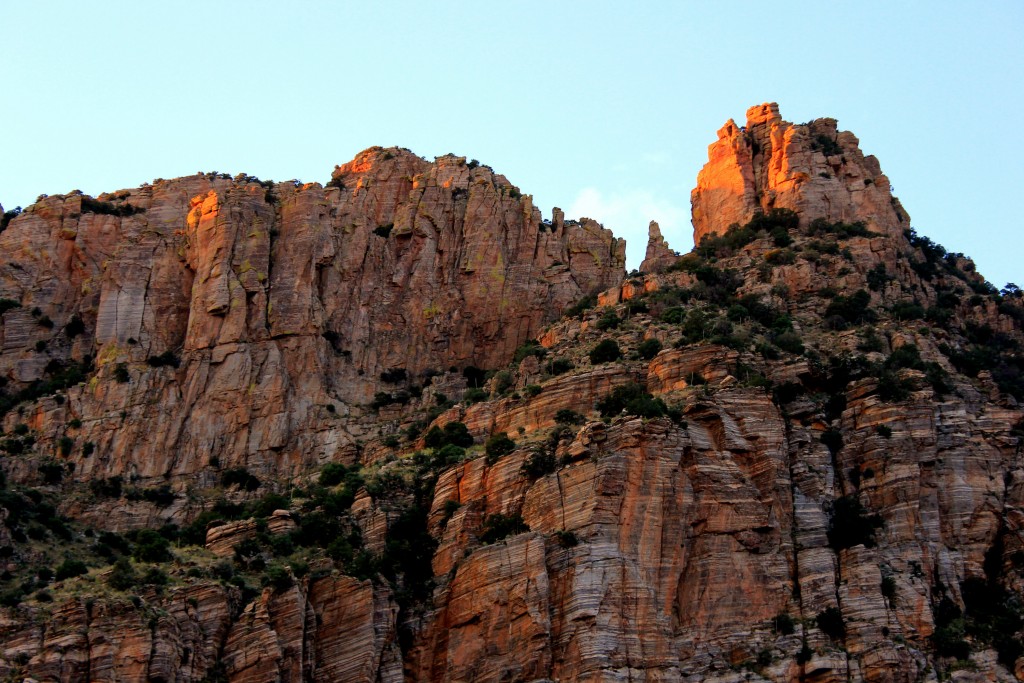
Superlative landscapes, beautiful sunsets, grand views and an exhilarating short climb to a lofty stone pinnacle are the drawing cards of Tucson’s Finger Rock Trail. Late fall through spring are the best times to pull off this trek.
We started early in the cool dawn air and hiked to Linda Vista Saddle, a steep and invigorating workout. In three miles we ascended over 3,000 feet and arrived at one of the few level spots along the trail. If we continued two more miles on the Finger Rock trail, we would have topped out at Kimble Peak, a worthy destination in its own right.
However, our goal today was to scale Finger Rock itself. We left the established trail and headed off to the northwest, down a gully then up a sketchy route, climbing another 1,000 feet. An hour and a half of scrambling and bushwhacking later, we were at the foot of Finger Rock, a slender pillar of lichen encrusted granitic gneiss which juts up 250 feet in spectacular fashion.
Guiding us on this perfect autumn day was Don Smith, an accomplished rock climber, caver, canyoneer, backpacker and avid adventurer. Don has been known to take lengthy sabbaticals and journey to fantastic locales such as the Yukon, Alaska and Belize. He takes folks to some remarkable places, including Tucson’s Finger Rock!
Don went first, set the anchor and belayed the rest of the group. We completed the first pitch then reached the midpoint of the climb. Don clambered up the rock, achieved the near high point of the Finger and secured the rope at strategically placed bolts. The rest of our crew, one by one, scrambled up to a high perch offering marvelous panoramas of numerous rock formations, the lofty crest of the Santa Catalina Mountains and the Tucson valley and beyond.
From there, it is a short scramble to the actual high point of Finger Rock, a precarious roost which can only accommodate one or two people. After spending about an hour enjoying the incredible spectacle, we rappelled 100 feet to the bottom of Finger Rock.
Three and a half hours later, after witnessing an awesome sunset, we all safely returned to the Finger Rock trailhead, rejuvenated after another splendid day of adventure in the mountains.
For an exciting glimpse of this astonishing trek, click on https://youtu.be/8plEYNCcxHw. Turn up your speakers and enjoy!
4. Rogers Canyon – Spirits of the Past in the Superstition Wilderness
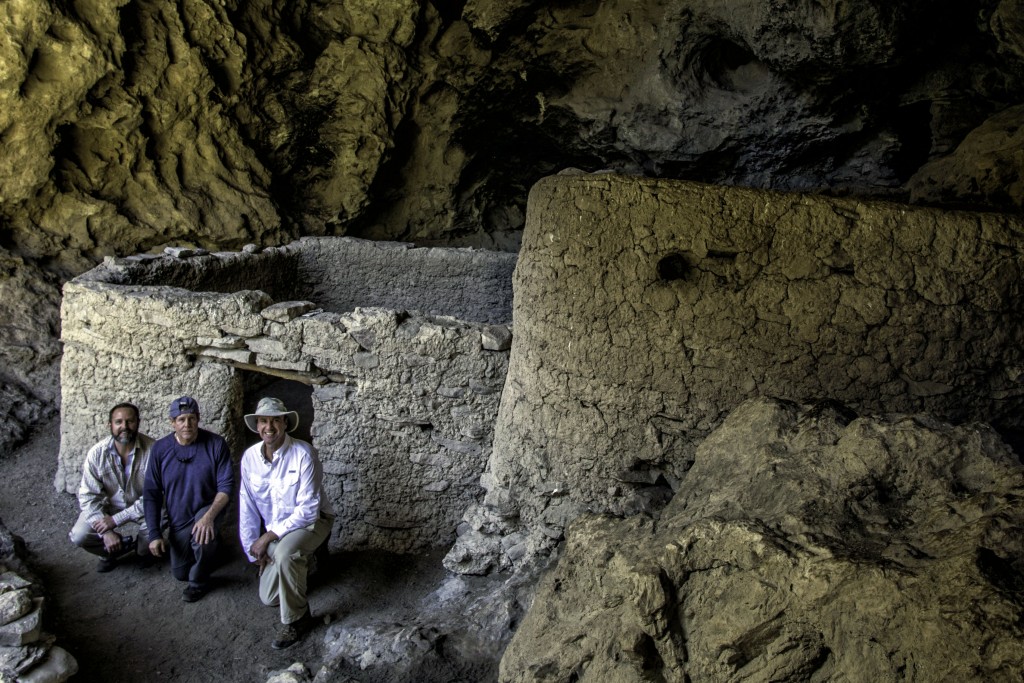
Most folks have hopes and dreams, some more grandiose than others. But few people are fortunate enough to realize all of their dreams. Elisha Reavis wanted to live off the land in a beautiful place far away from the hordes of humanity. He lived out his dream in a high mountain valley in Arizona’s Superstition Mountains where he farmed, grazed and tendered an orchard. Ponderosa pines graced his ranch and a beautiful clear spring-fed creek watered the fruit trees he planted. He died in 1896; his grave-site is located in a place few people will ever see. Thanks to Randy Weber, a Tucson hiker, historian and naturalist, we were one of the few.
500 years before Reavis departed, the Salado peoples were eking out a living in Rogers Canyon. So we headed left at the Rogers Canyon trail junction to observe the fascinating cliff dwellings. Gradually, the character and look of the landscape transformed from high desert grassland to riparian. Huge old sycamore trees, juniper, oak and mountain laurel appeared. As we ventured deeper into the thick of Rogers Canyon, spectacular volcanic rock formations made their appearance. Various shapes chiseled by the elements resembled a teapot, Queen Victoria’s crown and a huge boulder perched precariously high up on the canyon wall.
Finally, we arrived at the Salado cliff dwellings. These well preserved ruins, located in a huge cave above the canyon floor, were the highlight of our day. At one time, as many as 100 people lived here and there were more than 65 rooms when it was constructed over 600 years ago. Most of the ruins have all but vanished but there is still a lot to see. The view from the ruins, looking out across the canyon was fantastic, a sight to behold. The ruins are fragile and irreplaceable; the forest service asks that hikers tread lightly and respect this magnificent place.
The long and bumpy drive from Rogers Trough trailhead is almost as striking as the hike itself. To the west views of saguaro studded Byous Butte, especially at sunset, are glorious. About six miles down the road on the right, we observed a picturesque stone arch. Numerous ridges and peaks of the Superstitions as well as other sky islands in the distance were prevalent throughout the journey back to civilization.
5. Adventuring at Nankoweap

For hikers wanting to experience raw adventure and avoid crowds, the Nankoweap trail at the Grand Canyon is one of the most enjoyable and epic treks in the southwest. Spectacular geology and out of this world views are the calling cards of this magnificent place. Nankoweap is located at the North Rim of the Grand Canyon.
The trail was originally constructed by Major John Wesley Powell, the one armed civil war veteran and explorer in 1882. It was created so that Charles Doolittle Walcott, a geologist in the Powell party, could easily be able to access the canyon and study its rock layers. Powell is best known for his epic explorations down the Green and Colorado Rivers and is credited with leading the first group of men down the Colorado River in 1871, through present day Grand Canyon.
Julie Dobson, who runs a travel adventure website called Escaping the Midwest, (http://escapingthemidwest.com/2016/01/22/the-words-of-john-wesley-powell/), recently posted a few of Powell’s most famous quotes about the Grand Canyon. Powell wrote, “the elements that unite to make the Grand Canyon the most sublime spectacle in nature are multifarious and exceedlingly diverse.”
In 2015 I had the pleasure of guiding a group of adventurers down the Nankoweap Trail. The first three miles were a delightful romp through a high elevation forest of ponderosa pine, juniper and aspen. Then suddenly, the trail took on an entirely different character. The route plunged off the rim of the Grand Canyon and a long ridge-top traverse ensued. After hiking two more miles, all the while gazing at amazing far reaching views, we arrived at Marion Point. Coming into contact with the geology in this part of the Grand Canyon was incredible, rock layers reached far back into our planet’s past from 300 million to 750 million years ago.
Wonderful and unbelievable panoramas unfolded. The visible green ribbon along Nankoweap Creek was 2,500 feet below us. The forks of Nankoweap Creek extended far back toward the plateau, each separated by colorful rocky ridges and lofty buttes. The most striking of these was Mt. Hayden, a distinct and slender 400 foot Coconino sandstone spire at an elevation of over 8,000 feet. Marion Point can also be the turn around location for hikers interested in a spectacular but rigorous ten mile roundtrip day hike.
But our group’s plan was to trek further into the heart of the Grand Canyon (backpacking experience and appropriate gear are highly recommended). Our long ridge-top traverse continued. After we reached Tilted Mesa in just over two miles, the route led steeply down to Nankoweap Creek and the Colorado River. Near the river, high cliffs of Redwall Limestone and beautiful exposures of Muav Limestone and Bright Angel Shale were the dominant features. Our first view of the emerald green Colorado River in the distance was mesmerizing. Not only did we finally see the river but we heard the roar of Nankoweap Rapids, amplified by red and tan walls at Marble Canyon.
Our group camped at the Colorado, which proved to be an excellent base for exploring further afield. We trekked seven miles upstream along bubbling Nankoweap Creek and discovered intriguing places such as Mystery Falls, a set of cliff top Anasazi granaries, and a fascinating cave featuring a stream running through it.
Should the Grand Canyon be included on your bucket list? Most certainly. And the spectacular and uncrowded Nankoweap trail is one of the best ways to experience the real Grand Canyon, the raw and unspoiled grandeur of this most magnificent gorge, one of the seven natural wonders of the world.













